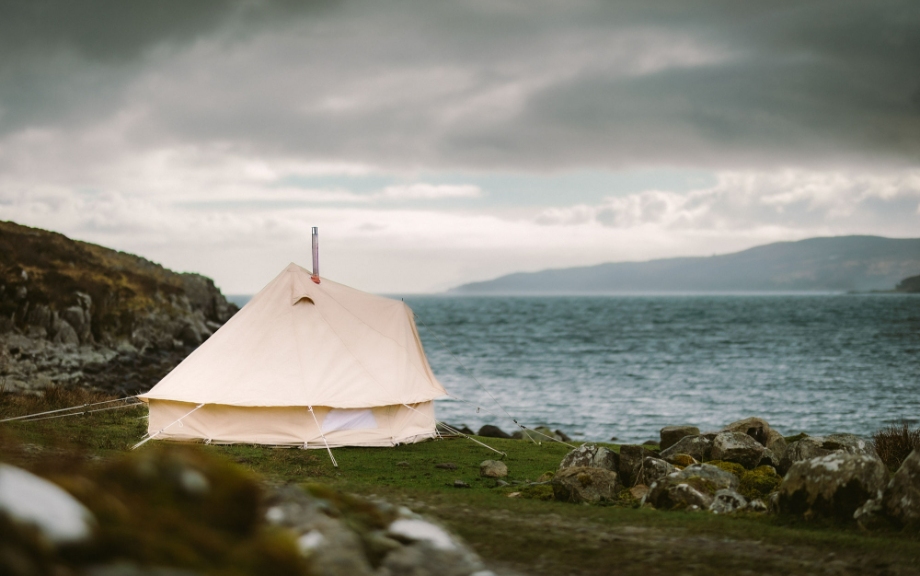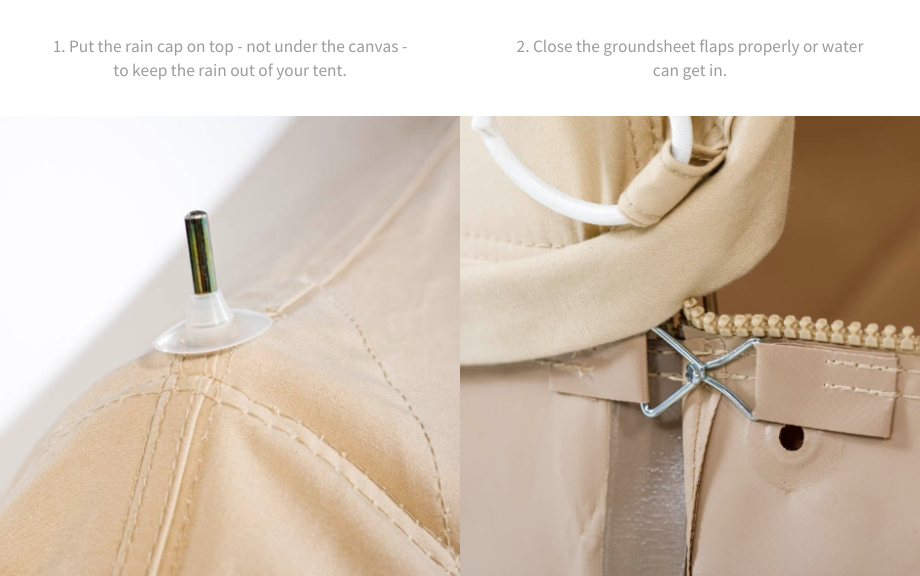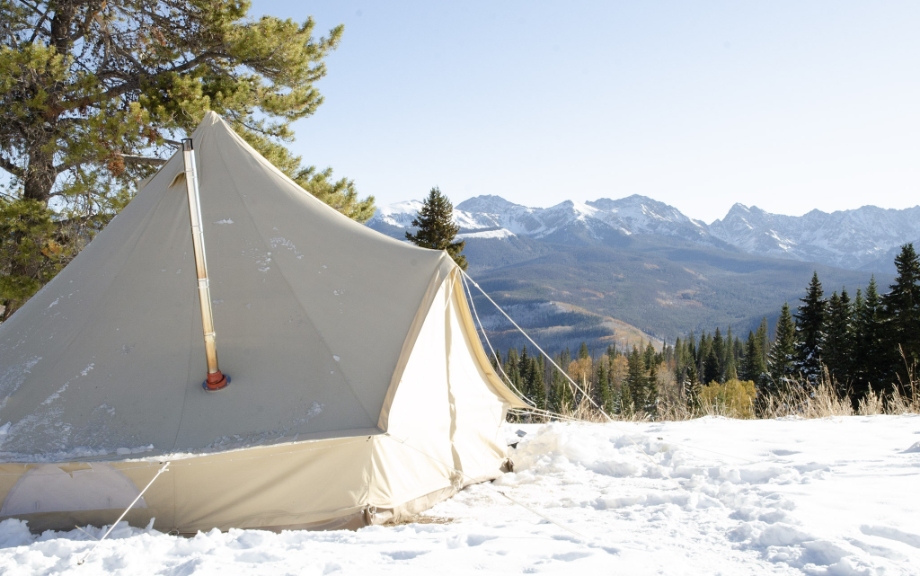How the Weather Impacts Your Tent

Source: Claudio Gregolin
For tent owners, few things compare to the joy of sleeping under the stars, surrounded by nature's beauty. However, the elements can be unpredictable, and your trusty cotton canvas tent is at the mercy of Mother Nature's whims. Fear not! In this informative guide, we'll explore how different weather conditions can affect your tent and provide you with essential tips to care for and protect your home away from home. Get ready to weatherproof like a boss and keep your tent standing tall, rain or shine.
Don't Let It Rain on Your Parade

Rain can put a damper on any camping trip, but with proper care, your cotton canvas tent can brave the storm.
Here's what you need to know:
● Waterproofing is key: Before you embark on your outdoor escapades, treat your tent with a reliable waterproofing product. This is only necessary if you see that the canvas is not 100% water repellent anymore (can occur if continually pitched for an extended period of time).
● This simple step will significantly enhance its water resistance. If your CanvasCamp tent is brand new, you don’t need to do this as it has already been waterproofed. If your tent is a seasoned veteran, you’ll need to retreat it. We like to use Ultramar (EU) or DryGuy (USA).
● Pitch perfect: Choose a well-drained campsite and ensure that your tent's rainfly or vestibule is properly secured. Make sure your guy lines are taut. This will help divert rainwater away from the tent body. Avoid those pesky puddles by setting up camp on higher ground. A little elevation goes a long way when it comes to staying dry. See how our tents can withstand a small flood with the groundsheet correctly installed.
● Ventilation matters: While rain protection is crucial, remember to maintain adequate airflow by leaving vents partially open. This prevents condensation buildup, ensuring a dry and comfortable interior.
Pro Tips:

Sun's Out, Fun's Out (But Not for Your Tent)
While we all love basking in its warm embrace, your tent might not feel the same way. Prolonged exposure to the sun's powerful rays can take a toll on your cotton canvas tent.
Here's how to keep it cool:
● Show some love: Treat your tent to some TLC by using a Sibley Fly to protect it from UV rays and debris. The Fly will keep your tent cooler and extend its life. It's like a hat for your tent!
● Don’t pitch under a tree. It’s tempting to seek shade under a tree, but tree sap and bird poop is a tent killer.
● Gentle cleaning: Regularly clean your tent to remove dirt and debris that can trap heat and increase sun damage.
Pro Tip: Follow these guidelines for proper cleaning techniques.
Which Sibley Fly is the best for your tent?
- Use the UV Protect if it's pitched where it’s warm, dry and not under a tree.
- Use the All Purpose Fly if it’s pitched where it’s warm, cold, humid or under a tree. The All Purpose is for all weather and all conditions. CanvasCamp tents are dyed with natural pigments. Just like sunkissed hair, your tent can also be bleached by the sun and can change color with time.
Gone with the Wind
When it comes to wind, we're all about "go with the flow," but not when it comes to our tents. A strong gust of wind can turn your cozy shelter into a flying circus.
Follow these tips to keep your tent grounded:
● Stakes are high: Use sturdy tent stakes and secure them deep into the ground. For added stability, make sure your guy lines are straight out and tightened to minimize movement.
● Optimal tent orientation: Position your tent's door or main opening away from prevailing winds. This reduces the chance of wind entering and destabilizing the tent structure.
● Reinforce with care: If you anticipate strong winds, reinforce your tent by adding heavy duty rebar stakes, however for most windy nights, the stakes provided with your CanvasCamp tent are sufficient.
These simple measures can significantly enhance wind resistance.
Good to know: Our Sibley tents have been wind tested and rated. Tests have shown that when the tents are properly pitched, staked, and tensioned, a Sibley 400 can withstand winds up to 120 kph (75 mph), the Sibley 500 up to 95 kph (60 mph), and Sibley 600 in winds up to 80 kph (50 mph). It is recommended that the Sibley 700 and 800 should be taken down in strong wind.
Pro Tip: Going to Burning Man? Check out these tips for pitching your tent in Black Rock Desert
Embrace the Winter Wonderland

The beauty of winter camping—where the crisp air fills our lungs and the landscape transforms into a mesmerizing wonderland. But beware, my frosty friends, for snow can be both enchanting and burdensome.
● Brush off accumulated snow from your tent's roof daily to prevent excessive weight that will cause structural damage. Remember, a little shake and shimmy can go a long way in preserving the integrity of your winter hideaway.
● Pitch wisely. Setting up your tent in the snow isn’t the same as pitching it on solid ground.
Pro Tips:
- Read about snow load
- Watch how to remove snow from a Sibley bell tent
- Learn how to pitch a tent in deep snow with dead man anchors
Battling the Moisture Monster
Humidity, the silent nemesis of all things comfortable. It can wreak havoc on your cotton canvas tent by promoting mold and mildew growth.
● Dry It Out, Baby: Make sure your tent is completely dry before packing it away. After a camping adventure, resist the temptation to stuff your canvas tent into its storage bag straight away. Give it time to dry thoroughly to prevent that musty odor or mold from taking up residence.
● When camping in humid conditions, use ventilation to your advantage by leaving windows and vents open. And always remember, a well ventilated tent is a happy and odor-free tent!
Pro Tips:
- Learn how to remove mold from your tent
- Learn how to take care of your canvas tent properly
- Hang your tent on a clothesline to promote airflow and make your neighbors wonder why you're drying out your portable mansion!
Last man standing: What it means to keep your tent pitched permanently
Keeping your tent pitched all the time means you’re either living in it, have a glamping business or you just like how it looks in your backyard. All good, but that means you’ll have to do some extra maintenance to keep your tent standing proud.
Leaving a canvas tent pitched outside for an extended period can subject it to the harsh elements, leading to gradual wear and tear of the fabric. Prolonged exposure to sunlight, rain, and debris can compromise the tent's integrity, making regular care and maintenance essential
for preserving its longevity.
● If you don’t use your tent for a few weeks, take it down.
● If you’re not going to be around, take the tent down as wind, snow, rain can damage your tent if you’re not there to keep an eye on it
(This is especially true with snow. The added weight can bend or break the center pole).
● If it’s pitched for longer than 5 months continually, make sure you follow these guidelines for proper cleaning techniques to keep your tent happy. Leaves fall, grass grows, dust settles, birds poop; all of this can speed up the aging process of your canvas tent.
Conclusion
Now you know that caring for your cotton canvas tent is the key to enjoying the great outdoors in any weather condition. By taking proactive steps to protect your tent from the elements, you can ensure a comfortable and long-lasting camping experience. Remember to waterproof, shield from UV rays, and secure against gusts, and you'll be well-prepared for nature's unpredictable whims. And never EVER pack your tent wet! Now, gather your gear, set up camp with confidence, and create unforgettable memories in your trusted canvas sanctuary.
Happy camping!



